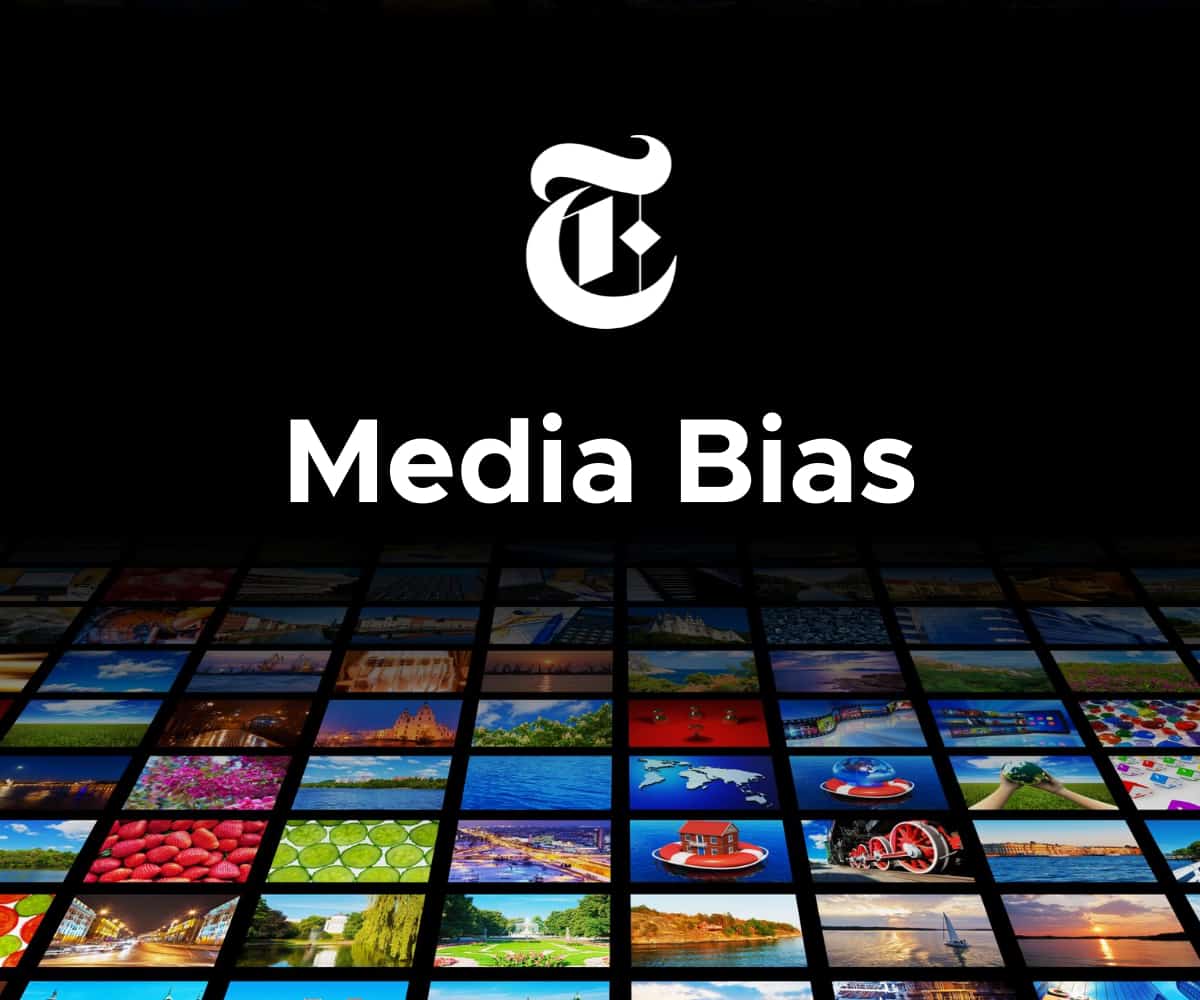
Since its early beginnings in 1851, the New York Times has risen to become one of the most prominent and widely circulated publications in the United States — ranking third in the U.S., according to Pew Research — with 132 Pulitzer Prizes to boot.
As a leading digital and print newspaper with a reputation for quality journalism, the question of whether The New York Times is biased demands close examination. According to Pew Research, the partisanship and ideological leaning of the Times’s readers are predominantly liberal (36%) and moderate (35%) with some conservative readership (22%):
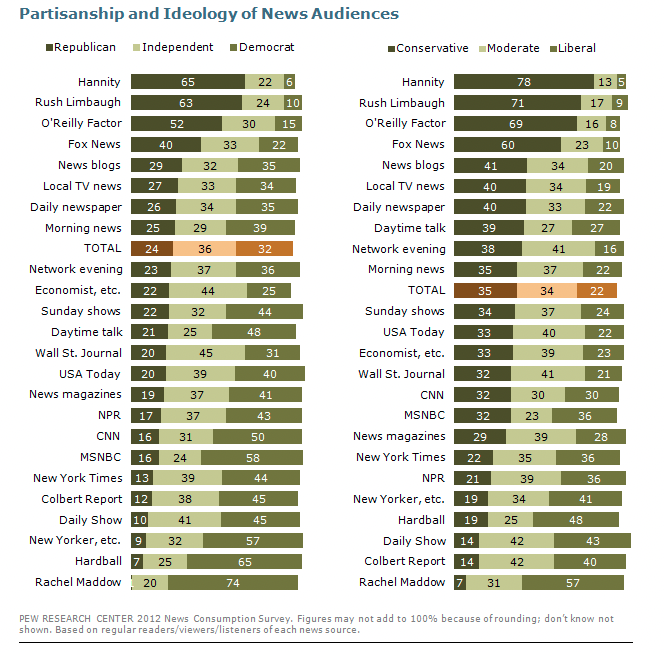
Source: Pew Research
In this article, we will analyze the newspaper’s coverage and editorial decisions to determine if there is a discernible political bias in their reporting. Through our analysis, we hope to provide a comprehensive answer to whether The New York Times is biased and shed light on the factors that contribute to media bias in general.
How Does Biasly Rate News Sources?
Biasly’s algorithms produce bias ratings to help provide multiple perspectives on given articles. Biasly has analyzed 200,000+ news articles from more than 3,200 news sources through our A.I. technology and team of political analysts to find the most factual, unbiased news stories.
Biasly determines the degree of political bias in news sources by using Biasly’s Bias Meter Rating, in which Biasly’s team analyzes media sources’ reliability and bias and produces three scores, a Reliability Score that measures the accuracy of media sources; an A.I. Bias Score, evaluated by A.I.; and an Analyst Bias Score evaluated by political analysts. These scores are rated based on seven rating metrics including Tone, Tendency, Diction, Author Check, Selection/Omission, Expediency Bias, and Accuracy. These metrics help our analysts to determine the political attitude of the article.
Our A.I. machine-learning system employs natural language processing and entity-specific sentiment analysis to examine individual articles and determine their bias levels. By analyzing the key terms in an article such as policies, bias phrases, political terminologies, politicians, and their nicknames, the algorithms can rate the attitude of the text. Bias scores range from -100% and 100%, with higher negative scores being more liberal and higher positive scores being more conservative, and 0% being neutral.
Is the New York Times Politically Biased?
Biasly’s rating for the NY Times is based on two scores, one from its computer algorithms which are based on A.I., and one from its Analysts. Biasly rated the New York Times with a Computer bias score of Very Liberal and an Analyst bias score of Moderately Liberal , which means, overall, it provides political coverage from an American liberal political perspective. Analyst scores are based on an average of at least 15 articles with each being reviewed by one liberal, moderate, and conservative analyst. The more articles rated by Bialsy’s analyst team for a particular source indicates a more accurate analyst score. As Biasly rates more articles, the scores will become more accurate. Praise for liberal politicians and policies as well as dislike toward Republican policies and politicians contribute to this rating. Biasly’s scores closely align with determinations by other third-party bias research agencies.
The New York Times has faced recent criticism by liberals, independents, and conservatives alike for being biased in favor of far-left causes — a fact that the Times has admitted itself:
“One reader from California who asked not to be named believes Times reporters and editors are trying to sway public opinion toward their own beliefs. ‘I never thought I’d see the day when I, as a liberal, would start getting so frustrated with the one-sided reporting that I would start hopping over to the Fox News webpage to read an article and get the rest of the story that the NYT refused to publish,’ she says.
“Here’s frustration as it crests, from James, an Arizona reader: ‘You’ve lost a subscriber because of your relentless bias against Trump — and I’m not even a Republican.’
“You can imagine what the letters from actual conservatives sound like.
“Emails like these stream into this office every day. A perception that The Times is biased prompts some of the most frequent complaints from readers.”
Readers like you are more likely to have a strong opinion of the New York Times based on your political leaning because of their tendency to favor liberal causes and people as represented by Biasly’s “Very Liberal” rating. In the remainder of this article, we’ll talk about ways to identify this bias so you can separate the opinions from the facts and become a more informed consumer of news.
Before we begin, we need to discuss bias. Bias is a natural function of humans, and we can express it both consciously and unconsciously. Bias is one of the most fundamental forms of pattern recognition in humans. This isn’t to lower the bar and say that “all things are biased,” but to explain the process in which we may come to trust certain news organizations that display patterns of coverage.
On the media’s part, there is an incentive to retain audiences, encourage them to purchase subscriptions, and rate products positively. Bias is a two-way street, people want to see news stories about things they care about, and the media needs viewers to continue their operations. This creates a positive feedback loop that influences what stories are covered and from what perspective. This also explains the actions of more liberal news organizations.
Analysis of Bias in NY Times Online Articles
Pew Research has discovered that the primary audience of the New York Times tends to be college-educated, knowledgeable about current events, between the ages of 18 and 49, and have a moderately high income. Given their educated and well-informed readership base, is the New York Times really biased? We’ll look at some of their articles in more detail below to identify the signs.
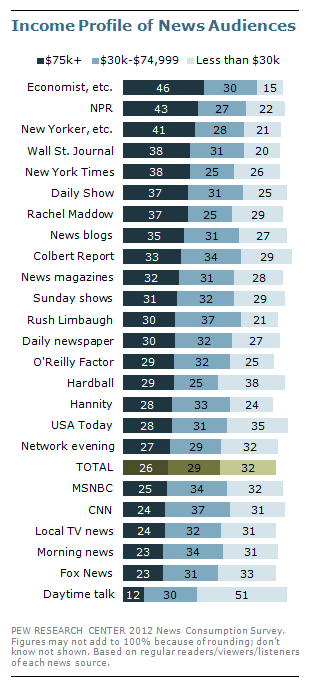
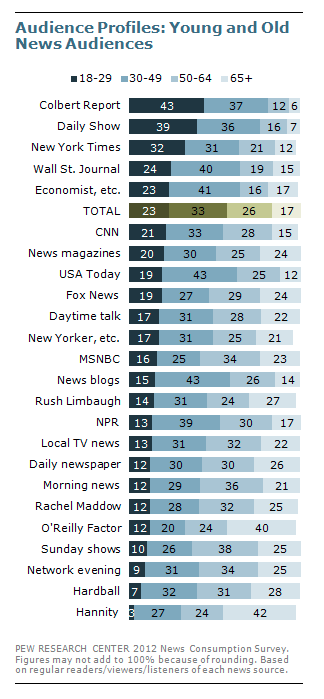
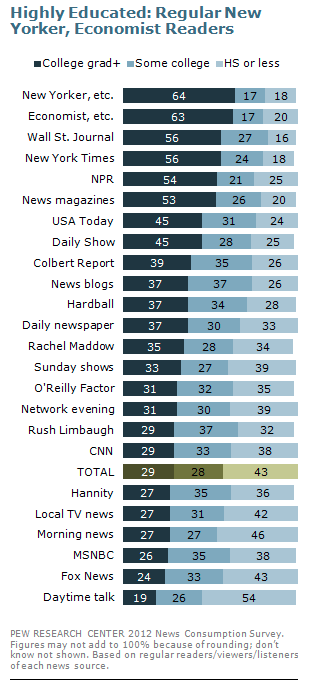
Source: Pew Research
When determining bias, some of the most common metrics used include Tone, Tendency, Author, Diction, and Expediency Bias, which are the primary metrics we’ll focus on below. Tone refers to the attitude of the writing and is related to but distinct from diction, which is the writer’s word choices. The Author metric refers to the author of the article and his or her demonstrated stance on issues through past articles and social media posts.
Moreover, tendency measures the consistency of an author’s tone or bias. A ‘Neutral/Moderate’ tendency indicates a balanced approach with no consistent bias. ‘Somewhat Liberal/Conservative’ shows slight, occasional bias, though the author generally tries to remain neutral. A ‘Very Liberal/Conservative’ tendency means the author often, but not always, leans towards a particular viewpoint. In an ‘Extremely Liberal/Conservative’ scenario, the bias is very evident throughout the article, favoring one side.
Finally, expediency bias relates to the initial impression from an article’s headline, images, or summary. ‘Neutral/Moderate’ expediency bias presents information fairly without delay or misleading elements. ‘Somewhat Liberal/Conservative’ indicates a slight favoritism in headlines and images. ‘Very Liberal/Conservative’ expediency bias shows apparent favoritism for one viewpoint in the headline and pictures. Lastly, ‘Extremely Liberal/Conservative’ expediency bias is when headlines and images blatantly favor one side, often resembling clickbait.
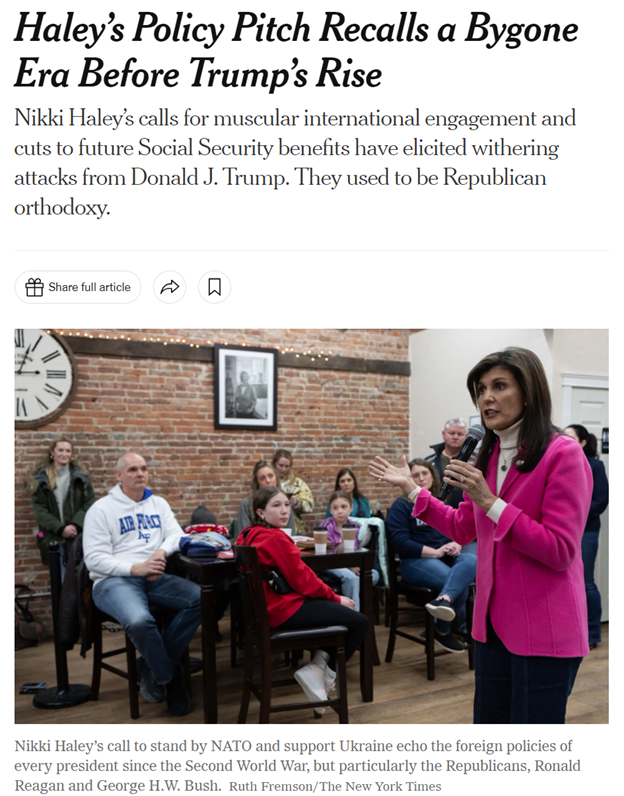
Source: New York Times
For example, the photograph in this article shows Nikki Haley addressing a modestly sized audience. This image may imply limited support; however, it could be misleading due to the selective nature of imagery, as small events might take place for closer interaction with voters. Additionally, the article’s title frames Haley’s policies as reminiscent of pre-Trump politics, potentially casting them as out-of-date in the current political scene. Influenced by expediency bias, this portrayal may skew public perception by emphasizing immediate reactions to her policies rather than their long-term implications.
Moving forward, the first article we’ll examine is entitled “Lawmakers threaten to withhold major funds from Native tribes over treatment of descendants of the enslaved.” Biasly has rated this article as “Somewhat Liberal.” Part of the reason for this rating is that, even though the author tries to maintain neutrality, the tone suggests that he wants the tribes to restore the rights of Freedmen.
The tone is made clear from the get-go of the article when the author states that the House withholding funds from tribes:
“[adds] to renewed public pressure to end policies that discriminate against descendants of Black people who were enslaved by the tribes before the Civil War.”
Once he covers the Reconstruction Era history and how tribes altered the Constitution to redefine citizenship, the author then uses the following sentence in isolation:
“Freedmen were listed separately from ‘by blood’ tribal members in the census.”
This was done to underscore the importance of the issue and is emphasized by the next paragraph, which reads, “Tribes now face pressure from two branches of government to recognize the Freedmen.”
Although the diction of the article is not necessarily extreme, it clearly rejects the stance of tribes excluding Freedmen. For example, the author uses the word “expulsion” to refer to the rejection of the Freedmen. Rep. Waters also says she believes that the provision should be implemented because tribes have “no intention” of equal rights for Freedmen.
In terms of the author himself, Chris Cameron’s Twitter profile reveals many of his biases and personal opinions in his re-tweeted stories concerning left-leaning topics such as January 6th, US foreign policy that destabilizes developing countries, Native Americans/Freedmen, and voting rights/protections.
Joe Biden is seeking to reunite a sprawling anti-Trump coalition that led him to victory in 2020 and blunted what was predicted to be a “red wave” midterm election in 2022. Highlighting Trump’s most divisive qualities will be central to that strategy. https://t.co/gp4TVvCo48
— Chris Cameron (@ChrisCameronNYT) January 5, 2024
In the article, Cameron consistently demonstrates omission bias in selectively gathering quotes from government officials that favor pressuring tribes to recognize Freedmen. For example, he includes quotes from Maxine Waters like, “…for one minority group to discriminate against a minority group, I don’t intend for that to stand.” He excludes the tribes’ perspectives that cite “tribal sovereignty” and self-governance for justifying blood as their requirement for citizenship. While he did include the perspective from the Cherokee tribal chief that “urged the committee to not hold housing funding hostage over the issue,” this is more neutral than the reasoning of the other side.
To sum it up, the author strives for objectivity for the most part and provides select perspectives from sources that don’t favor the bill’s provisions, but he ultimately spins the story to support one side. All of this suggests that, while some elements of this article were neutral, the article was found to be left-leaning overall, which aligns with our analysis of the New York Times as a company with a tendency to lean left in its biases.
Even though this article falls on the left end of the spectrum, article bias can differ between articles and authors, even when they come from the same organization. This shows the importance of looking for the signs of bias — including (but not limited to) tone, tendency, diction, author, and expediency bias — in any article you come across.
To demonstrate, here’s one more article that demonstrates little to no bias throughout and also comes from the NY Times: “The Biden administration imposes new sanctions on Syrian prisons and officials.” Biasly’s A.I. rating is “Center,” as the language throughout is very cut-and-dry, objectively stating the facts of the matter and avoiding emotionally loaded language that influences the reader’s opinion:
“The Biden administration imposed new sanctions on a group of Syrian prisons and officials on Wednesday as part of its effort to pressure the government of President Bashar al-Assad to end human rights abuses.
“The sanctions were the first to be directed at Syria by the Biden administration, which called for a resolution to the civil war that has gone on for more than a decade.”
The only trace of bias in this article is the author’s own Tweets concerning left-wing topics; however, these do not seem to influence the content of the article.
Analysis of NY Times Opinion Articles
Before we answer this question, we need to draw the distinction between opinion and reporting. While reporting is intended to be neutral, giving the reader the facts and quotes from primary sources to let them form their own opinion, opinions are an outlet for columnists to express their personal views on the issues of the day. While we saw elements of factual reporting in the analysis above, the NY Times opinion pieces don’t seek objectivity but prioritize putting forth an opinion instead.
Consider the opinion article “Trump’s Day of Martyrdom Didn’t Go Quite as He Expected.” The title is loaded with bias because it contains language suggestive of a negative opinion or judgment about Trump’s intentions or actions. Specifically, the word “martyrdom” implies that Trump is a victim or a hero, but in this context, it is used sarcastically to influence the reader’s opinion before they read the article. The preemptive criticism of the former president and the bias present in the title suggests that the author does not intend to provide a fair and objective reporting of the facts.
However, the article “The Texas Voting Bill, Explained” has a more objective title, focusing on informing the reader rather than pushing an agenda. Reliable articles are marked by neutral language and facts from credible sources. Based on the title alone, it could be safely assumed that this article would be less biased than the one previous.
These articles, in addition to those above, are only a small representation of all of the NY Times content, but they indicate that the outlet is often characterized by a great deal of opinion — further underscoring the importance of knowing how to distinguish subjective writing from genuine reporting.
Who Owns the NY Times?
The New York Times is traded publicly and, therefore, is owned by its shareholders. However, the Ochs-Sulzberger family has been a significant influence on the company since 1896, when Adolph Ochs purchased the newspaper. The current chairman of the board is Arthur Gregg Sulzberger. While his family’s political affiliation is not stated outrightly, this family has a significant influence on the bias of the paper, as they have a tradition of appointing their own members as publishers and editors who are tasked with upholding the paper’s reputation. Given the liberal slant of most NY Times articles, it can reasonably be assumed that the Sulzbergers favor Democrat ideology and causes.

Source: Wikipedia
However, Sulzberger states that his long-term goal is to build relationships and trust “with a whole different section of readers, by meeting them where they are, in the form that they want to be met at.” This could suggest that the company could be striving for more centrality and less left-wing bias in the near future.
How to Evaluate and Uncover Bias
It can often be difficult to tell if the news you watch is biased. If you have settled on a news channel, it’s usually because you trust the information you are gaining. Unfortunately, many trust the information they are hearing because it confirms what they already believe. This is referred to as “confirmation bias.” It is important to challenge your beliefs and get third-party verification that what you are hearing is the full story. This is why we recommend using Biasly to compare different news stories side-by-side using our bias ratings to figure out what both sides think of a political issue.
Even though Biasly gave the New York Times a Very Liberal bias score, remember that bias varies by article, and the New York Times does not exclusively publish liberal thought pieces. In fact, it is known to have produced some centrist and conservative-leaning articles before. Additionally, some article types will inherently have more or less bias; general news articles are known for being less biased than opinion pieces. And while every article you read will be biased to some degree, some stick to the facts better than others, which is why it’s so important to use Biasly’s News Check to help you determine the bias of what you read.






















